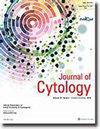肛门鳞状上皮内病变hTERT基因表达和7号染色体拷贝数变异的初步研究
IF 1
4区 医学
Q4 MEDICAL LABORATORY TECHNOLOGY
引用次数: 0
摘要
背景:与宫颈鳞状上皮内瘤变(CIN)类似,肛门鳞状上皮内病变(a-SIL)可归因于高危人类乳头状瘤病毒感染的持续感染。已知人类端粒酶逆转录酶(hTERT)基因扩增和非整倍体与CIN进化相关。a-SIL中潜在的遗传事件是相似的,这是有道理的。我们进行了这项横断面分析研究,目的是确定hTERT基因表达和7号染色体的表达,作为a-SIL中细胞倍性的标志。方法:对86名有接受性肛交(RAI)史的成年受试者和4名无接受性肛性交史的对照者进行常规肛门细胞学检查。对a-SIL病例和对照组进行荧光原位杂交(FISH),以评估hTERT基因和7号染色体的表达,作为细胞倍性的标志。结果表示为异常细胞核的数量(分别≥3个信号)、最大扩增程度、平均信号/细胞核和显示异常细胞核的病例比例。结果:a-SIL 20例;15例不典型意义不明的鳞状细胞(ASCUS)、3例低度鳞状上皮内病变(LSIL)和2例高危细胞学检查。hTERT基因和7号染色体的表达从对照组增加到ASCUS再到LSIL,同时hTERT和7号基因表达异常的病例比例增加。结论:hTERT基因与a-SIL呈正相关,提示其可能在肛门鳞状细胞异常的进化中发挥作用。7号染色体的增加也与a-SIL呈正相关。这些发现证实了CIN鳞状上皮癌变和a-SIL之间的相似性。本文章由计算机程序翻译,如有差异,请以英文原文为准。
Evaluation of hTERT Gene Expression and Chromosome 7 Copy Number Variation in Anal Squamous Intra-Epithelial Lesions: A Pilot Study
Background: Akin to cervical squamous intra-epithelial neoplasia (CIN), anal squamous intra-epithelial lesion (a-SIL) is attributed to persistent infection with high-risk human papilloma virus infection. Amplification of human telomerase reverse transcriptase (hTERT) gene and aneuploidy are known to correlate with CIN evolution. It is plausible that the underlying genetic events in a-SIL are similar. We conducted this cross-sectional analytical study with the objective of determining expression of hTERT gene expression and chromosome 7, as marker of cell ploidy in a-SIL. Methods: Conventional anal cytology was performed in 86 adult consenting subjects with history of receptive anal intercourse (RAI) and 4 controls without history of RAI. Cases with a-SIL and controls were subjected to fluorescent in-situ hybridization (FISH) to evaluate hTERT gene and chromosome 7 expression, as marker of cell ploidy. Results were expressed as number of abnormal nuclei (≥3 respective signals), maximum degree of amplification, mean signals/nucleus and proportion of cases showing abnormal nuclei. Results: Twenty cases showed a-SIL; with 15 atypical squamous cells of undetermined significance (ASCUS), 3 low grade squamous intra-epithelial lesion (LSIL) and 2 cases of high-risk cytology. Expression of both hTERT gene and chromosome 7 increased from controls to ASCUS to LSIL with concomitant increase in proportion of cases having abnormal hTERT gene and chromosome 7 expression. Conclusions: Positive association of hTERT gene with a-SIL suggests its possible role in evolution of anal squamous abnormalities. Increase in chromosome 7 also correlated positively with a-SIL. These findings corroborate the similarities between squamous carcinogenesis in CIN and a-SIL.
求助全文
通过发布文献求助,成功后即可免费获取论文全文。
去求助
来源期刊

Journal of Cytology
MEDICAL LABORATORY TECHNOLOGY-
CiteScore
1.80
自引率
7.70%
发文量
34
审稿时长
46 weeks
期刊介绍:
The Journal of Cytology is the official Quarterly publication of the Indian Academy of Cytologists. It is in the 25th year of publication in the year 2008. The journal covers all aspects of diagnostic cytology, including fine needle aspiration cytology, gynecological and non-gynecological cytology. Articles on ancillary techniques, like cytochemistry, immunocytochemistry, electron microscopy, molecular cytopathology, as applied to cytological material are also welcome. The journal gives preference to clinically oriented studies over experimental and animal studies. The Journal would publish peer-reviewed original research papers, case reports, systematic reviews, meta-analysis, and debates.
 求助内容:
求助内容: 应助结果提醒方式:
应助结果提醒方式:


